The 1968 Code of Points was to be ready by May 1, 1968. Opening ceremonies for the 1968 Olympics were set for October 12, 1968. That’s not a lot of time to read the Code and adjust routines.
Thankfully, compared to the men’s Code, the women’s Code was much shorter. Let’s take a look at some of the most salient parts.
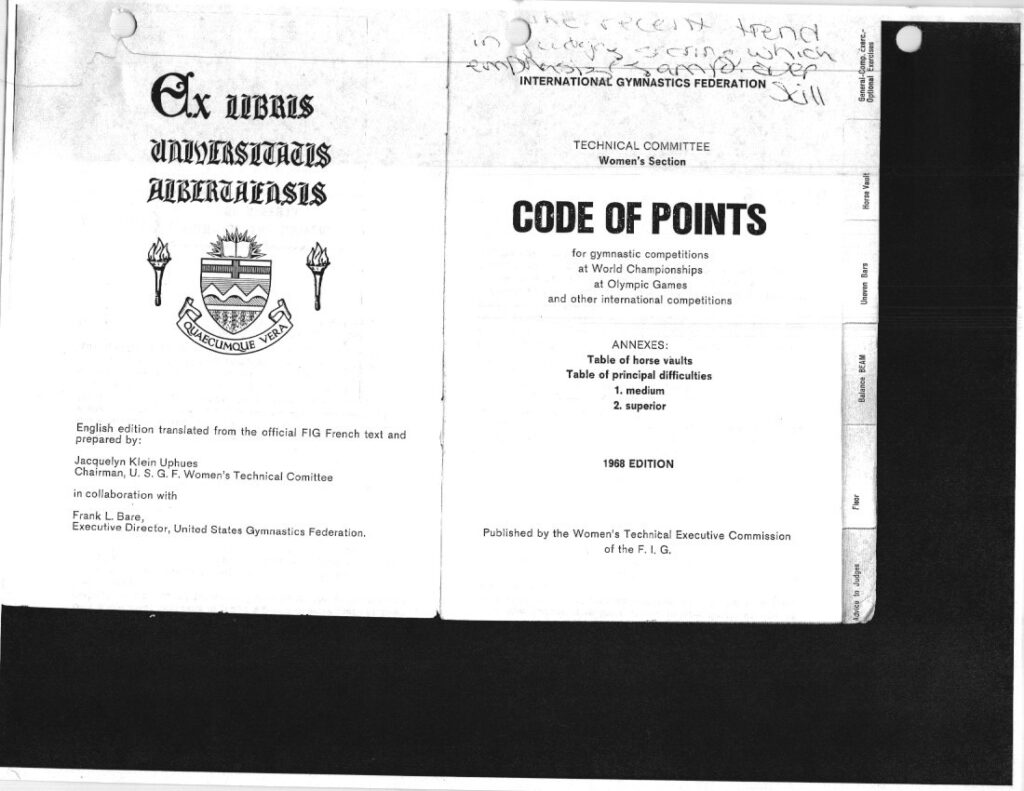
The Number of Judges
Prior to 1968, there were five judges. The highest and lowest scores were dropped, and the three remaining scores were averaged.
In 1968, the women’s technical committee adopted the men’s judging structure:
- 4 judges + a superior judge
- The highest and lowest scores were dropped
- The two remaining scores were averaged
My soapbox: To understand the history of women’s gymnastics, you have to understand the history of men’s gymnastics, as well. And vice versa.
Something that makes me laugh
For the finals, the score sheet should be printed with all the detailed point values, and the judges will mark carefully accordingly and take into consideration the originality and the value of the sequences.
But only for finals? For the compulsory and optional competitions, the judges didn’t have to “mark carefully” and could write down whatever score they wanted?
Breaking down the 10.0
- Routine composition: 6 points
- 4 points: value of the difficult elements
- 1.5 points: originality and value of the combinations (connections)
- 0.5 points: value of the general composition of the exercise (structure)
- Execution of the exercise: 4 points
- 1.50 points: execution
- 1.50 points: amplitude
- 1.00 points: general impression
Exercises had to include:
- 4 elements of medium difficulty (0.50 each element)
- 2 elements of superior difficulty (1.0 each element)
- Total: 4 points
My thought bubble: They needed more difficulty categories. A round-off + back handspring + back tuck was considered just as difficult as a back full.
On Compulsory Repetitions
Gymnasts could no longer repeat their compulsory exercises. (Before, they could.)
On Skill Repetitions
Gymnasts could repeat skills of medium and superior difficulty in succession. Examples cited in the Code:
- 2 flip-flops
- 2 somersaults
- Several difficult leaps having the same amplitude
Vault Notes
- Gymnasts did not have to stick their landings. They could take one step upon landing as long as it was executed “in the direction of the descent” and “not provoked by unbalance.”
- There was a whole host of deductions

Vault used to be one of the lower-scoring events. Can you see why? There was a myriad of deductions.
Also, if you watch old vaults, you’ll notice that the Reuther board was placed extremely far from the horse. That’s because judges could deduct up to 1.50 for “insufficient flight between the board and the horse.”
Bars Notes
Stops were allowed, but they were subjective:
The exercise must be continuous; two stops at the maximum are authorized at the time, if they are necessary, for being in balance, and in a brief period of concentration before the difficult element.
Article 13, 1968 Code of Points
Balance Beam Notes
Rhythm was big on beam:
- No slow, monotonous routines
- No stops before each element of difficulty
- Rhythm must be varied, “sometimes alive, sometimes slow”
Length of beam routines:
- Between 1 minute 20 seconds and 1 minute 45 seconds.
- The warning signal went off at 1 minute 40 seconds.
- A second signal went off at 1 minute 45 seconds.
There was a distinction between touching your hands on the beam vs. falling off the beam.
- Falling on the floor: 1.00
- Support of hands on beam to maintain balance: 1.00
- Touching hands on beam for purpose of maintaining balance: 0.5
Note: Remember this. We will return to these deductions during Čáslavská’s optional beam routine in Mexico City.
Floor Notes
The composition of a gymnast’s routine was supposed to be in accordance with:
- the level of difficulty throughout the exercise
- the “morphology of the gymnast”
- the “temperament of the gymnast”
My thought bubble: A gymnast’s routine was supposed to fit her body type (“morphology”). That’s… problematic. And my guess is that “angry” was not supposed to be the gymnast’s temperament.
Don’t make weird faces or emote too much.
Forced and artificial expressions must be avoided, they must be left to the area of modern choreographic attitudes, which under the pretext of originality, often detract from the aesthetic beauty of the exercise.
Don’t use loud music.
The loud background music is to be rejected.
The music follows the gymnasts’ movements — not the other way around
The composition of a floor exercise necessitates a close collaboration with the pianist who constructs (the ideal) the melody according to the parts of the exercise.
Reserve Gymnasts as Sacrificial Lambs for Judges’ Meetings
The participating Federations must send their substitute gymnasts to the course for judges in order to be of service for reason of experience, the estimation, and assessment of the exercises.
Modesty is a must.
The attire must be correct and made of non-transparent cloth.
All uniforms judged to be improper (immodest) will bring to the gymnast a penalty of 0.30 points.
Next up: The Unwritten Rules
Those are the written rules. There were many unwritten rules that President Villancher had in mind (e.g. tan lines and choosing music for “large” gymnasts).
We’ll take a look at some of those rules in the next post.
Apparatus Norms
Here are a few of the apparatus norms that were in place in 1968.
Note: The apparatus norms didn’t change when the Code changed. They could change at any time. For example, the uneven bars changed in 1967.
I’m simply placing the apparatus norms in this post so that they have a home on this site.
Vault
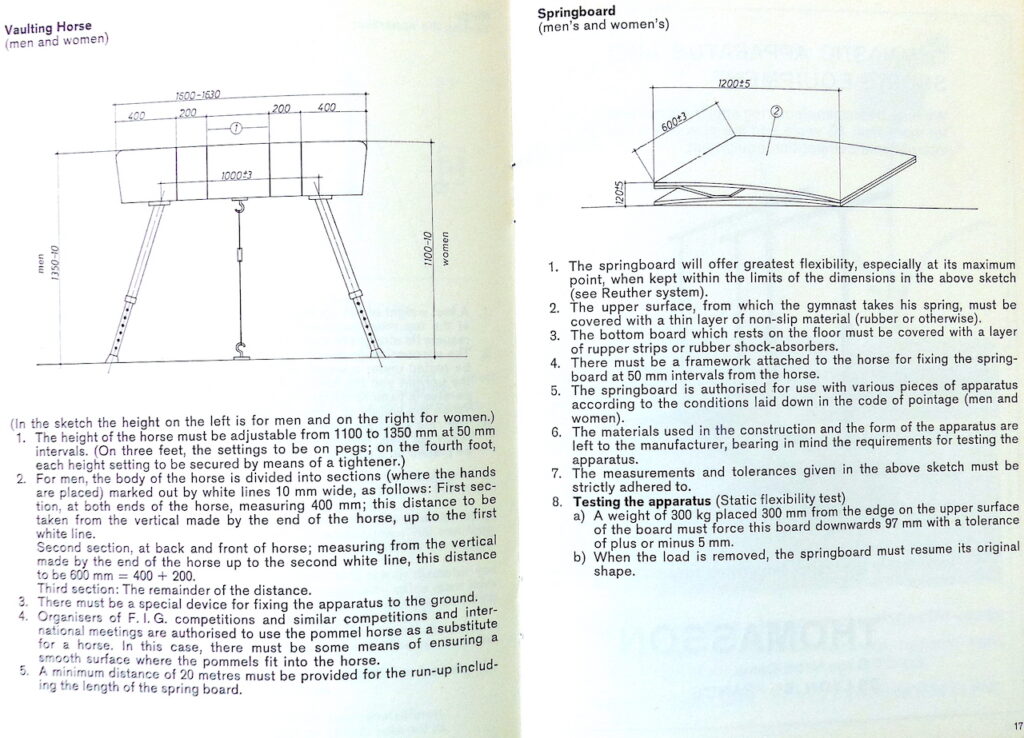
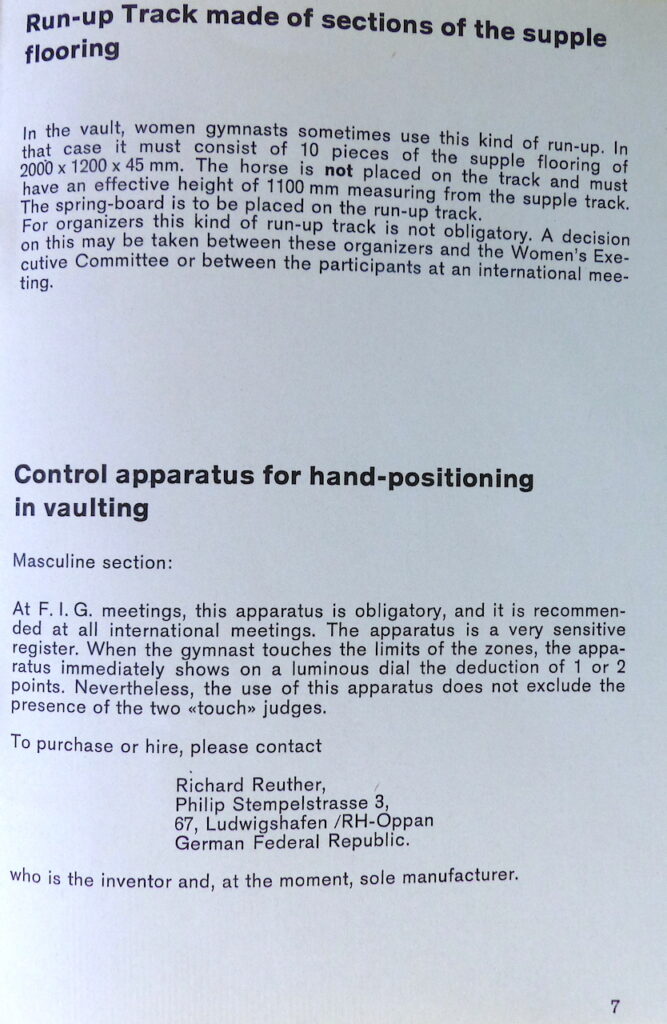
The vault was 15 cm (5.91 in.) lower than it is today, and they used Reuther boards, which are not springboards.
Uneven Bars
Starting with the 1967 European Championships, the FIG started using tension uneven bars. Before that, they essentially used a set of parallel bars with a brace. (You can read more about that here.)
Just how close were the bars? Here are the apparatus guidelines from the FIG (1967):
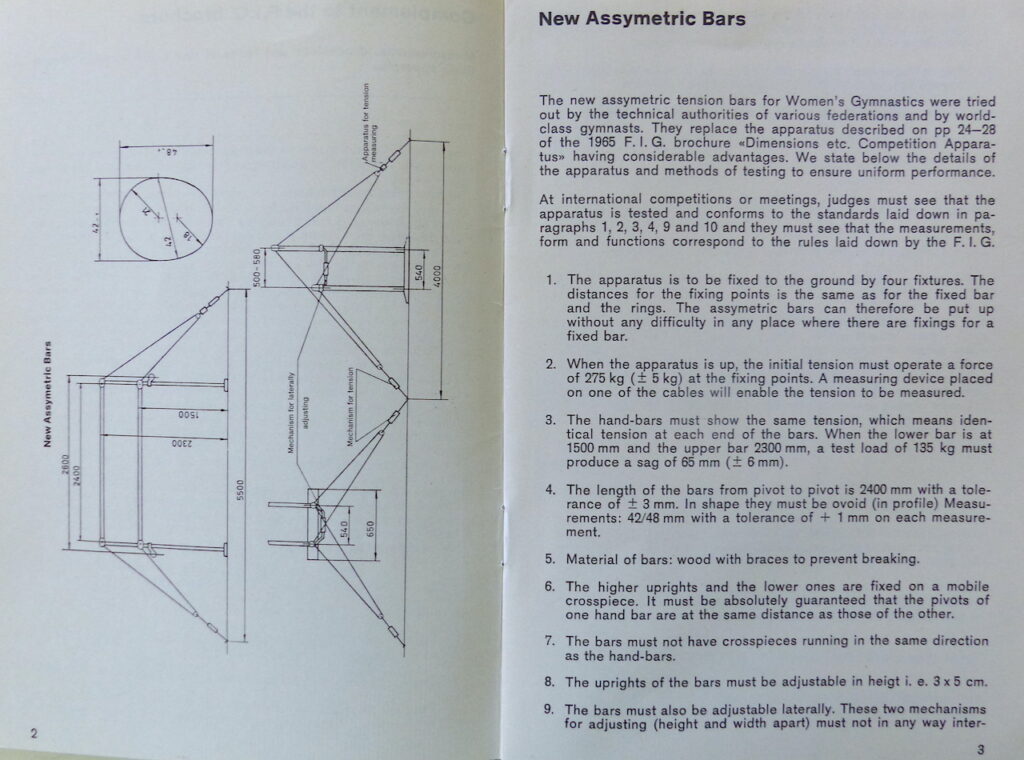
The width of the bars had to be between 50 cm (19.69 inches) and 58 cm (22.83 inches). The “new asymmetric bars” gave the gymnasts 6 extra centimeters. Before, the maximum width was 52 cm.
Floor Exercise
At FIG events, the gymnasts competed on the double flex floor (sometimes called the “double swing floor” or the Reuther floor). It was essentially two floorboards sandwiched together with small wooden inserts between the layers. (Eventually, there would be foam blocks and rubber balls between the layers.) You could see it as a precursor to the modern spring floor.
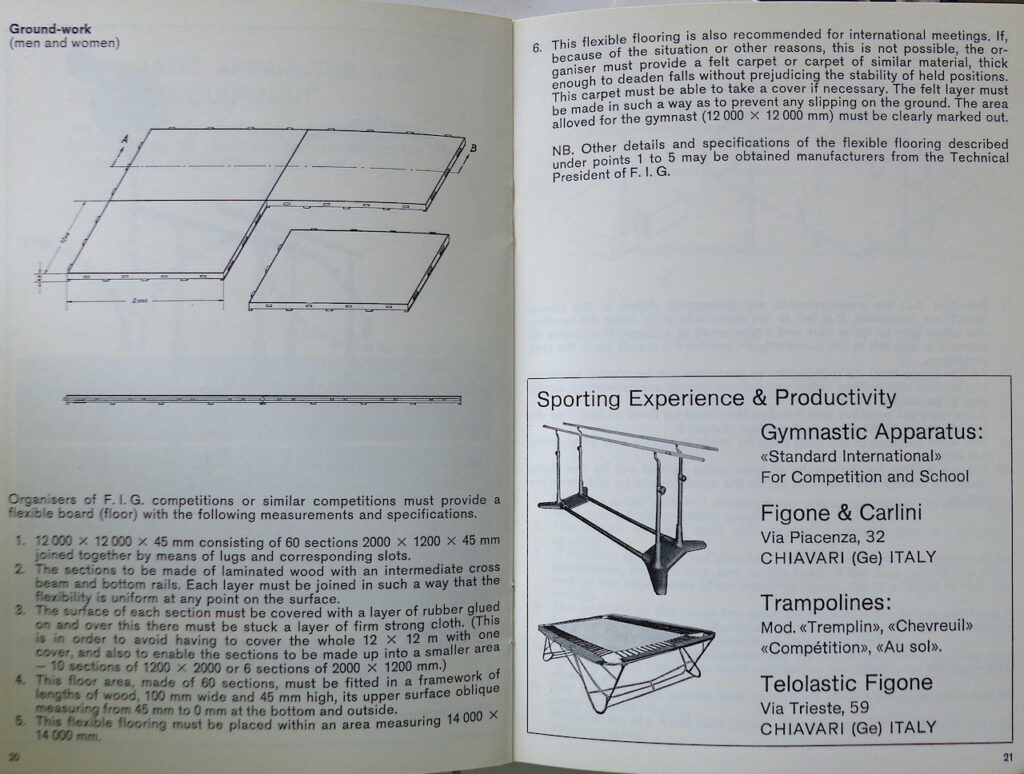
Many thanks to Hardy Fink for the photos of the apparatus norms.
More Codes of Points
More on 1968